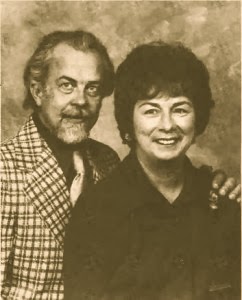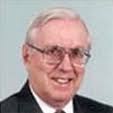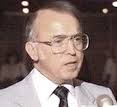By Charles Lear

On December 17, 1969, the Air Force issued a press release through the Office of Assistant Secretary of Defense (Public Affairs) announcing the termination of the Air Force’s UFO investigation, Project Blue Book. With the end of Project Blue Book, UFO investigation was left to private organizations, and the two most prominent at the time were the Aerial Phenomena Research Organization, run by Jim and Coral Lorenzen, and the National Investigations Committee on Aerial Phenomena, directed by Maj. Donald E. Keyhoe (USMC-Ret.). Besides the challenge of now being the two main places to turn to for citizens wanting to make UFO reports, both groups were about to face some major changes in their organizational structures that would lead to the demise of one and create a major rival for the other.
 In the July 1969 issue number 20 of Skylook, a publication started in September 1967 by Missouri residents John Kuhns, Norma Short, and Ted Phillips Jr., it is announced that Skylook is now the official publication of the Midwest UFO Network. The magazine staff at this point is listed as Norma Short, Ted Phillips Jr., John Schuessler, Walter Andrus, and Lucius Farish. Schuessler is described as an APRO consultant, and Andrus as co-chairman of Illinois Section APRO and Illinois state director of the Midwest UFO Network. There is a description of the group’s formation process and it is mentioned that the group would be “affiliated with APRO but not controlled by APRO through a ‘dotted line’ relationship.”
In the July 1969 issue number 20 of Skylook, a publication started in September 1967 by Missouri residents John Kuhns, Norma Short, and Ted Phillips Jr., it is announced that Skylook is now the official publication of the Midwest UFO Network. The magazine staff at this point is listed as Norma Short, Ted Phillips Jr., John Schuessler, Walter Andrus, and Lucius Farish. Schuessler is described as an APRO consultant, and Andrus as co-chairman of Illinois Section APRO and Illinois state director of the Midwest UFO Network. There is a description of the group’s formation process and it is mentioned that the group would be “affiliated with APRO but not controlled by APRO through a ‘dotted line’ relationship.”
The “affiliation” wouldn’t last long. According to “A Brief History of MUFON,” written by John Schuessler, “the APRO management reacted to the government’s words (shutting down Project Blue Book) by reinforcing their centralized management approach.” One can see a hint of this in the July-August 1969 APRO Bulletin. In an article on page 2 headlined, “Field Investigators Network,” the reader is told this: “Once the Field Investigators Network is running smoothly, APRO will notify the Investigator closest to the scene of a UFO incident and receive a prompt and accurate report.”

According to Schuessler, Andrus was getting “a flow of reports” and needed to train investigators on his own and oversee investigations “in his own backyard.” Andrus plead his case to APRO, but they became “more determined that the Midwest Contingent was a hindrance rather than a help to APRO.” In response, Andrus contacted investigators from Wisconsin, Illinois, Kansas, and Missouri and held a meeting on May 31, 1969. It was there that Allan R. Utke, an APRO consultant and associate professor of chemistry at Wisconsin University, proposed the creation of the Midwest UFO Network.
The Midwest UFO Network became the Mutual UFO Network in 1973 and continues under that name as of this writing.
As MUFON grew, so did a sense of rivalry between that group and APRO. This came to a head during the 1980 Cash-Landrum case. Curt Collins wrote about this in a blog headlined “MUFON vs. APRO, Allegations, Accusations & Countercharges:
The Cash-Landrum UFO Case Backstage Drama,” posted on his site Blue Blurry Lines. There, he provides links to documents that give an indication as to how at odds the two groups had become. In a letter dated July 27, 1982, written by Coral Lorenzen to Robert Barrow, she calls Andrus “a first-rate liar.” She then adds this: “He is, almost single-handedly, responsible for the mogrelization of UFO research with his promoting of pea-brains who do his bidding and add names to his list of ‘State Directors’, [sic] etc., ad nauseum.”

Donald E. Keyhoe was removed as the director of NICAP in 1969. The organization died a slow death after that and there has been speculation that the CIA had a hand in it. Todd Zechel wrote about the CIA – NICAP connection in the January 1979 issue of Just Cause, the newsletter put out by Citizens Against UFO Secrecy. NICAP was incorporated in 1956, and two men Zechel argues were covert CIA operatives were put into chair positions within the organization. One of these men was Bernard J. O. Carvalho, who was made the chairman of NICAP’s membership subcommittee. According to Zechel, Carvalho worked as a “front man” for companies secretly run by the CIA. The other was “Count” Nicolas de Rochefort, who was made Vice-Chairman of NICAP. According to Zechel, de Rochefort worked with the CIA’s Psychological Warfare Staff. Zechel tells the reader “there is more than ample evidence to conclusively establish both de Rochefort and Carvalho were at least during certain periods of their lives covert employees of the Central Intelligence Agency.”
The director of NICAP for its first year was T. Townsend Brown. Brown was replaced by Major Donald E. Keyhoe (USMC – Ret.) at the end of 1956, and Carvalho and de Rochefort left shortly thereafter. Keyhoe had been a classmate of Vice-Admiral Roscoe Hillenkoetter (USN – Ret.) at the Naval Academy in Annapolis, Maryland, and he got Hillenkoetter to agree to sit on NICAP’s board of governors. Hillenkoetter was the first director of the CIA, so this is a definite connection between the CIA and NICAP.
It doesn’t seem as if Hillenkoetter was under any direct influence by the CIA while he was with NICAP. Hillenkoetter’s publicly stated beliefs aligned with those of Keyhoe and NICAP, and he openly accused the Air Force of misleading the American public when it came to UFOs and urged action by Congress to “reduce the danger from secrecy.”
In 1962, Hillenkoetter seems to have had a change of heart. That year, he resigned from the board in the midst of Keyhoe’s efforts to get Congress to hold open hearings on UFOs and the Air Force’s handling of the problem. In his letter of resignation, Hillenkoetter wrote “The Air cannot do more under the circumstances . . . and I believe we should not continue to criticize their investigations . . .”
Zechel addresses the presence on the board at the time of his writing of Col. Joseph Bryan III (USAF – Ret.), whom he describes as the founder and original chief of the CIA’s Psychological Warfare Staff (1947-53). Zechel says that during interviews he held with Bryan, Bryan confirmed his CIA connections. Bryan asked that his position as a covert CIA operative not be made public and denied having any connection or communication with the Agency while he sat on NICAP’s board. When it was suggested to Bryan that two CIA covert agents had “penetrated NICAP at its very beginning,” Bryan replied “There’s nothing to penetrate about – it was all overt, the whole thing.”
After Keyhoe was removed as director (he was “kicked upstairs” and moved to the board) Jack Acuff took over. Acuff had been the head of the Society of Photographic Scientists and Engineers which, according to Zechel, “had been the target of frequent KGB spying attempts” due to the fact that many of its members were CIA photo analysts. Zechel says that Acuff had been approached by Soviet agents “on several occasions” and reported this to the FBI. He began meeting with the Soviets at the behest of the FBI “acting, in effect, as a covert agent.”
Another suspected CIA affiliate in the NICAP organization was G. Stuart Nixon who, in 1973, was an assistant to Acuff. Zechel references a document from the CIA where “an unnamed person . . . indicates some familiarity with G. Stuart Nixon.” Zechel also points out that daily NICAP logs “reflect that Nixon met with several past and present (then) CIA employees on a frequent basis.”
At the time of Zechel’s writing, NICAP was withering and close to death as an organization, and Acuff had been replaced by Alan C. Hall, “a retired CIA employee living in Bethesda.” Zechel concludes his article by bringing up the theory that the CIA had purposely destroyed “the leading anti-secrecy organization of the 1960s” and stops short of agreeing with this.
This possibility was debated online by NICAP insiders, including Fran Ridge Gordon Lore, and Jan Aldrich, as recently as 2018, and they were unable to agree on whether it was the CIA or just poor management that killed NICAP.
The CIA – NICAP connection was looked into deeply by Jack Brewer in his 2021 book, “Wayward Sons: NICAP and the IC. Brewer did extensive research and filed FOIA requests and was unable to positively identify any of the suspected CIA covert agents as such, though the evidence he presents appears convincing. Brewer leans towards the idea that the CIA helped set up the organization and used it as an asset for various purposes, including propaganda, leak detection and money laundering, and then put an end to it when it outlived its usefulness. He, like Zechel, stops short of reaching a final conclusion, so the question of whether or not the CIA had a hand in NICAP’s beginning and end remains an open one.